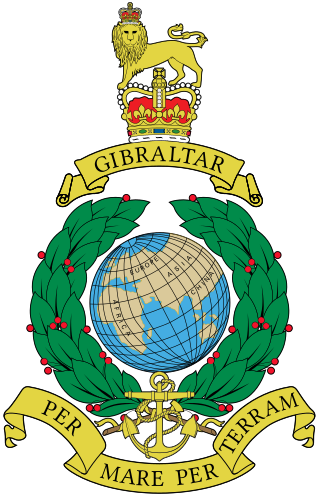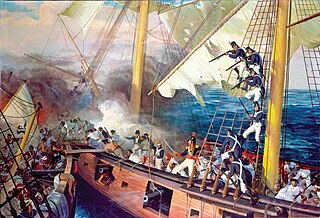
A commando is a combatant, or operative of an elite light infantry or special operations force, specially trained for carrying out raids and operating in small teams behind enemy lines.

The Royal Marines, also known as the Royal Marines Commandos, and officially as the Corps of Royal Marines, are the United Kingdom's amphibious special operations capable commando force, one of the five fighting arms of the Royal Navy, and provide a company strength unit to the Special Forces Support Group (SFSG). The Royal Marines trace their origins back to the formation of the "Duke of York and Albany's maritime regiment of Foot" on 28 October 1664, and the first Royal Marines Commando unit was formed at Deal in Kent on 14 February 1942 and designated "The Royal Marine Commando".

The Commandos, also known as the British Commandos, were formed during the Second World War in June 1940, following a request from Winston Churchill, for special forces that could carry out raids against German-occupied Europe. Initially drawn from within the British Army from soldiers who volunteered for the Special Service Brigade, the Commandos' ranks would eventually be filled by members of all branches of the British Armed Forces and a number of foreign volunteers from German-occupied countries. By the end of the war 25,000 men had passed through the Commando course at Achnacarry. This total includes not only the British volunteers, but volunteers from Greece, France, Belgium, Netherlands, Canada, Norway and Poland. The United States Army Rangers and US Marine Corps Raiders, Portuguese Fuzileiros Portuguese Marine Corps were modelled on the Commandos.

United Kingdom Commando Force (UKCF), previously called 3 Commando Brigade, is the UK's special operations-capable commando formation of the Royal Marines. It is composed of Royal Marine Commandos and commando qualified personnel from the Royal Navy, British Army and Royal Air Force.
This is a list of British ground forces in the Falklands War. For a list of ground forces from Argentina, see Argentine ground forces in the Falklands War

The 34th Division was an infantry division of the British Army that was raised in 1914, during the First World War. The division was raised from volunteers for Lord Kitchener's New Armies, originally made up of infantry battalions raised by public subscription or private patronage. The division was taken over by the War Office in September 1915. It served in France and Belgium in the trenches of the Western Front for the duration of the war.
The 102nd Brigade was an infantry formation of the British Army during World War I. It was raised as part of 'Kitchener's Army' and assigned to the 34th Division. After the original formation was converted into a reserve brigade, the number was transferred to a brigade of 'Tyneside Scottish', four 'Pals battalions' of the Northumberland Fusiliers recruited from men of (mainly) Scottish birth or heritage working on Tyneside. The brigade landed in France at the end of 1915 and then served on the Western Front for the rest of the war. The brigade suffered appalling casualties on the First day of the Battle of the Somme. It recovered to participate in the Battle of Arras in 1917, but was virtually destroyed during the German spring offensive of 1918. It was reconstituted with different units in time to take part in the final battles of the war and the post-war occupation of the Rhineland.

Marines are military personnel generally trained to operate on both land and sea, with a particular focus on amphibious warfare. Historically, the main tasks undertaken by marines have included raiding ashore and the boarding of vessels during ship-to-ship combat or capture of prize ships. Marines also assisted in maintaining security, discipline, and order aboard ships. While maintaining many of their historical roles, in modern times, marines also engage in duties including rapid-response operations, humanitarian aid, disaster relief, special operations roles, and counter-terrorism operations. In most nations, marines are an integral part of that state's navy, such as the United Kingdom's Royal Marines; in some countries their marine forces can also instead be part of the land army, such as the French Troupes de Marine; or, more uncommonly, a nation’s marine forces may be an independent military branch such as the United States Marine Corps or the Ukrainian Marine Corps.

The 25th Infantry Division was an infantry division of the Indian Army during World War II which fought in the Burma Campaign. It was re-raised within the post-independence Indian Army in 1948.
The history of the Royal Marines began on 28 October 1664 with the formation of the Duke of York and Albany's Maritime Regiment of Foot soon becoming known as the Admiral's Regiment. During the War of the Spanish Succession the most historic achievement of the Marines was the capture of the mole during the assault on Gibraltar in 1704. On 5 April 1755, His Majesty's Marine Forces, fifty Companies in three Divisions, headquartered at Portsmouth, Chatham and Plymouth, were formed by Order of Council under Admiralty control.
The 101st Rifle Division was a unit of the Soviet Red Army initially formed as a mountain rifle division on 28 August 1938 within the 2nd Separate Red Banner Army in Petropavlovsk-Kamchatsky city.

The 1st Special Service Brigade was a commando brigade of the British Army. Formed during the Second World War, it consisted of elements of the British Army and the Royal Marines. The brigade's component units saw action individually in Norway and the Dieppe Raid, before being combined under one commander for service in Normandy during Operation Overlord. On 6 December 1944, the Brigade was redesignated 1st Commando Brigade, removing the title Special Service and its association with the German SS.
The 8th/12th Regiment, Royal Australian Artillery, was formed at the Holsworthy Barracks on 16 November 1973 through the amalgamation of the 8th Medium Regiment (RAA) and the 12th Field Regiment (RAA). The Regiment provides field artillery support to the 1st Brigade based in Darwin. It is currently equipped with 155mm M777 Howitzers.
The 4th Special Service Brigade was a brigade-sized formation of the British Commandos formed during the Second World War in March 1944 from battalion-sized units of the Royal Marines. Due to the success of the British Army Commandos' operations in Norway, the Channel Islands, St. Nazaire, and the Middle East, the Admiralty dissolved the Royal Marines Division in late 1942 and reorganized its amphibious assault infantry into eight additional Commando units.
No. 5 Commando was a battalion-sized commando unit of the British Army during the Second World War.

The 4th Anti-Aircraft Division was an air defence formation of Britain's Territorial Army, created in the period of tension before the outbreak of the Second World War. It defended North West England during the Blitz.

The 101st Infantry Division was one the reserve divisions of the Philippine Army under the United States Army Forces in the Far East (USAFFE)'s 10th Military district mainly entire island of Mindanao.
The 102nd Infantry Division was a division of the Philippine Army under the United States Army Forces in the Far East (USAFFE).
After Davao Force was dispersed on December 24, 1941, they went missing and no contact, General Joseph Vachon sent Lieutenant Colonel Howard Frissell to Digos, Davao and setup defense of Digos Junction area to prevent Japanese drive towards Digos-Pikit road and reaching Kabacan the southern terminus of Sayre Highway.










